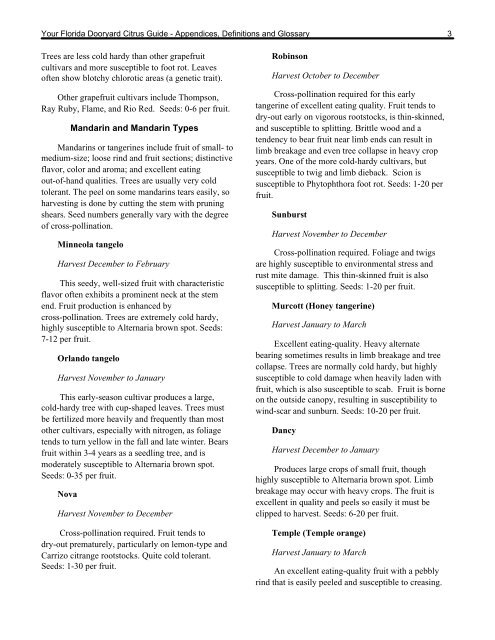Dooryard Citrus Guide - Appendices, Definitions and Glossary
Dooryard Citrus Guide - Appendices, Definitions and Glossary
Dooryard Citrus Guide - Appendices, Definitions and Glossary
You also want an ePaper? Increase the reach of your titles
YUMPU automatically turns print PDFs into web optimized ePapers that Google loves.
Your Florida <strong>Dooryard</strong> <strong>Citrus</strong> <strong>Guide</strong> - <strong>Appendices</strong>, <strong>Definitions</strong> <strong>and</strong> <strong>Glossary</strong> 3<br />
Trees are less cold hardy than other grapefruit<br />
cultivars <strong>and</strong> more susceptible to foot rot. Leaves<br />
often show blotchy chlorotic areas (a genetic trait).<br />
Other grapefruit cultivars include Thompson,<br />
Ray Ruby, Flame, <strong>and</strong> Rio Red. Seeds: 0-6 per fruit.<br />
M<strong>and</strong>arin <strong>and</strong> M<strong>and</strong>arin Types<br />
M<strong>and</strong>arins or tangerines include fruit of small- to<br />
medium-size; loose rind <strong>and</strong> fruit sections; distinctive<br />
flavor, color <strong>and</strong> aroma; <strong>and</strong> excellent eating<br />
out-of-h<strong>and</strong> qualities. Trees are usually very cold<br />
tolerant. The peel on some m<strong>and</strong>arins tears easily, so<br />
harvesting is done by cutting the stem with pruning<br />
shears. Seed numbers generally vary with the degree<br />
of cross-pollination.<br />
Minneola tangelo<br />
Harvest December to February<br />
This seedy, well-sized fruit with characteristic<br />
flavor often exhibits a prominent neck at the stem<br />
end. Fruit production is enhanced by<br />
cross-pollination. Trees are extremely cold hardy,<br />
highly susceptible to Alternaria brown spot. Seeds:<br />
7-12 per fruit.<br />
Orl<strong>and</strong>o tangelo<br />
Harvest November to January<br />
This early-season cultivar produces a large,<br />
cold-hardy tree with cup-shaped leaves. Trees must<br />
be fertilized more heavily <strong>and</strong> frequently than most<br />
other cultivars, especially with nitrogen, as foliage<br />
tends to turn yellow in the fall <strong>and</strong> late winter. Bears<br />
fruit within 3-4 years as a seedling tree, <strong>and</strong> is<br />
moderately susceptible to Alternaria brown spot.<br />
Seeds: 0-35 per fruit.<br />
Nova<br />
Harvest November to December<br />
Cross-pollination required. Fruit tends to<br />
dry-out prematurely, particularly on lemon-type <strong>and</strong><br />
Carrizo citrange rootstocks. Quite cold tolerant.<br />
Seeds: 1-30 per fruit.<br />
Robinson<br />
Harvest October to December<br />
Cross-pollination required for this early<br />
tangerine of excellent eating quality. Fruit tends to<br />
dry-out early on vigorous rootstocks, is thin-skinned,<br />
<strong>and</strong> susceptible to splitting. Brittle wood <strong>and</strong> a<br />
tendency to bear fruit near limb ends can result in<br />
limb breakage <strong>and</strong> even tree collapse in heavy crop<br />
years. One of the more cold-hardy cultivars, but<br />
susceptible to twig <strong>and</strong> limb dieback. Scion is<br />
susceptible to Phytophthora foot rot. Seeds: 1-20 per<br />
fruit.<br />
Sunburst<br />
Harvest November to December<br />
Cross-pollination required. Foliage <strong>and</strong> twigs<br />
are highly susceptible to environmental stress <strong>and</strong><br />
rust mite damage. This thin-skinned fruit is also<br />
susceptible to splitting. Seeds: 1-20 per fruit.<br />
Murcott (Honey tangerine)<br />
Harvest January to March<br />
Excellent eating-quality. Heavy alternate<br />
bearing sometimes results in limb breakage <strong>and</strong> tree<br />
collapse. Trees are normally cold hardy, but highly<br />
susceptible to cold damage when heavily laden with<br />
fruit, which is also susceptible to scab. Fruit is borne<br />
on the outside canopy, resulting in susceptibility to<br />
wind-scar <strong>and</strong> sunburn. Seeds: 10-20 per fruit.<br />
Dancy<br />
Harvest December to January<br />
Produces large crops of small fruit, though<br />
highly susceptible to Alternaria brown spot. Limb<br />
breakage may occur with heavy crops. The fruit is<br />
excellent in quality <strong>and</strong> peels so easily it must be<br />
clipped to harvest. Seeds: 6-20 per fruit.<br />
Temple (Temple orange)<br />
Harvest January to March<br />
An excellent eating-quality fruit with a pebbly<br />
rind that is easily peeled <strong>and</strong> susceptible to creasing.
















